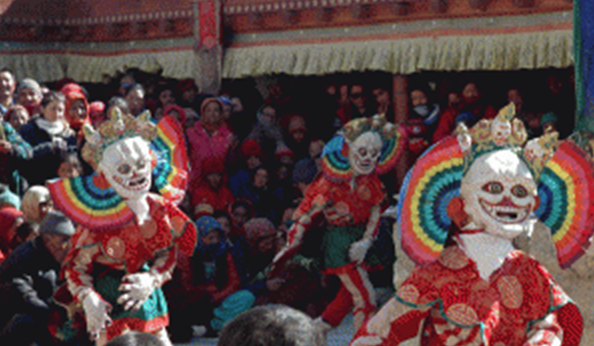Dosmochay Festival
This is a collection of articles archived for the excellence of their content. Readers will be able to edit existing articles and post new articles directly |
Dosmochay Festival
Two day Dosmochay Festival begins
By Reach Ladakh, Friday, February 8, 2013
Leh: Thousands of devotees converge at the courtyards of Leh Palace to witness the mask dance 'Chams' performed by the monks on the occasion of the winter festival 'Dos Mochay'. The two day festival ‘Dosmochey’ is the largest Buddhist ‘winter gathering’ in the capital Leh. The festival is also widely celebrated in Liker village of Ladakh.
Dosmochey also marks the celebration of coming Tibetan’s New Year. Held on the 28th & 29th of the Tibetan 12th month, the New year follows a day after throwing of ‘dos’ (Ling-Dzi-Che –Do) on the second day of Dosmochey celebration.
The monks from different monasteries of Ladakh perform the Chams every year on alternation. And this year monks (almost 40 in number) of Thiksay monastery are performing the 'Chams'. The offerings are prepared by the monks of Takthok monastery every year. The monks bind the ‘dos’ with thread crosses that symbolizes the trapping of all evil and hungry ghosts. The ceremony of ‘dos’ disposal which takes place the next day symbolises an effort to evade all the ills and bad omens from the land.
“The monks perform such chams and make stormas ‘dos’ to evade the bad omen which is the result of ‘hatred, jealousy and desire’. We believe that the deities are in realm of sadness because humans are busy in fetching place in these three traps. As a mark of pardon we perform such rituals, so that any natural disaster or mishap will not happen in future” said, Gen Longdol of Takthok Monastery. For the religious spectators, other then the mask dance at the Leh Palace’s Gompa Soma, the busiest chapels were the Tsemo, Chamba Lakhang and the Chandazik chapel.
The festival also offers the youths of Leh, an opportunity to hang out in the markets, which are put up especially for the festival. The scenario in the main Leh bazaar reflected glimpses of a typical Indian mela.
